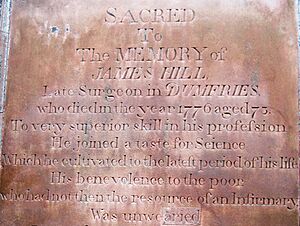James Hill (surgeon) facts for kids
James Hill (born October 30, 1703 – died October 18, 1776) was a Scottish surgeon. He worked in Dumfries and was known for his brave approach to treating cancer. Unlike many surgeons of his time, he believed in completely removing cancers to cure them, instead of just trying to ease the pain.
Hill carefully followed up with his patients for many years. This showed that his bold methods led to much better results than what other famous surgeons were achieving. He also became very skilled at treating brain bleeding after head injuries. His methods for this, which involved a surgery called trepanning, were the best published in the 1700s. They were a big step forward in how doctors handled serious head injuries.
Contents
Early Life and Training
James Hill was born in Kirkliston, West Lothian, Scotland, on October 30, 1703. His father, Rev James Hill, was a minister, and his mother was Agnes Muirhead.
In 1723, James became an apprentice to George Young, a well-known surgeon in Edinburgh. Young taught him to be a careful observer and to question things in medicine. This training was very important for Hill's future career. Like many apprentices, Hill attended lectures at Surgeons' Hall. However, he did not get a full surgical diploma or a medical degree from the new University of Edinburgh Medical School.
In 1730, Hill joined the Royal Navy as a surgeon. At that time, naval surgeons only needed to pass an exam from the London Company of Barbers and Surgeons. Many, like Hill, did not have other formal medical degrees.
Surgical Work in Dumfries
In 1732, James Hill returned to Dumfries and started his own surgical practice. On January 28, 1733, he married Anne McCartney. They made their family home on her father's estate, Blacket. Hill ran his practice from his house in Dumfries.
From 1742 to 1775, Hill trained sixteen young surgeons. One of them, Benjamin Bell (1749-1806), became internationally famous. Bell wrote a very successful textbook called A System of Surgery.
Hill's Medical Writings
James Hill wrote several articles for a medical journal called Medical Essays and Observations. This journal started in 1733 and was one of the first regular medical publications. It allowed doctors to share their patient cases and other medical findings.
Hill's articles show the wide range of health problems he treated as a surgeon. They also reveal his understanding of how these conditions started and how to treat them. For example, he wrote about two cases of a disease called hydatid disease. In these cases, patients had cysts coming out of their bodies, but they recovered without needing active treatment.
Cases in Surgery
In 1772, James Hill published his most important book, Cases in Surgery. This book summarized his many years of work as a surgeon. It covered topics like the infectious disease sibbens, different types of cancers, and head injuries caused by accidents.
Treating Cancers
Hill had strong beliefs about treating cancer. He thought that cancers should be completely cut out to cure them. This was different from what many leading European surgeons believed. Surgeons like Alexander Monro primus and Samuel Sharp often only removed a small part of the cancer to relieve symptoms, not to cure it.
Hill was able to look back at the results of surgery on 88 of his cancer patients. A remarkable 86 of them recovered from the surgery. Even better, 77 of these patients lived a normal lifespan afterward. These results were much better than those reported by other surgeons, like Alexander Monro primus. The cancers Hill treated were mainly skin cancers and some breast cancers. He knew it was hard to tell some cancers apart from harmless growths before modern tests existed. But his good results made him believe that all tumors, even small ones, should be "cut entirely out."
Understanding Head Injuries
The chapter in Cases in Surgery about "Disorders of the head from external violence" truly shows Hill as a careful doctor and a groundbreaking surgeon. He achieved amazing results for his time.
Hill described 18 cases of head injuries he treated over 40 years. He wrote down every detail: how the injury happened, the patient's symptoms, his treatment, and the final outcome. He explained that head injuries were being treated "much more rationally" thanks to new discoveries. Hill also shared how his own understanding and treatment methods improved over time.
One of his first patients was a five-year-old boy with a skull fracture and bleeding inside his head. When Hill lifted the broken bone and drained the blood by drilling a small hole in the skull (a process called trepanning), the boy immediately woke up. This case helped Hill understand that pressure on the brain caused symptoms like being confused or sleepy. He also realized that if one side of the body was weak, the injury was likely on the opposite side of the brain.
Hill's understanding of brain pressure was very advanced. He noticed that if the brain wasn't pulsing normally during surgery, it meant serious damage. His success rate for treating head injuries was 25% mortality, which was much lower than other famous surgeons of his time, like Henri François Le Dran (57%) or Percival Pott (51%). This was because Hill better understood when and where to perform trepanning.
Hill's Lasting Impact
James Hill passed away on October 18, 1776, and is buried in St Michael's churchyard in Dumfries. His work greatly improved how doctors understood and treated head injuries. He showed that bleeding inside the skull could be recognized by symptoms and successfully treated by surgery to relieve pressure. His insights were a major step forward in understanding brain injuries and how to treat them.


